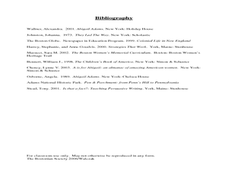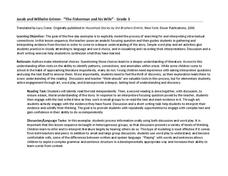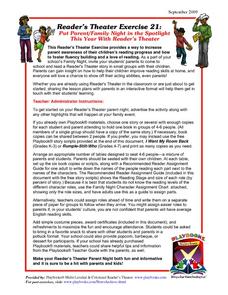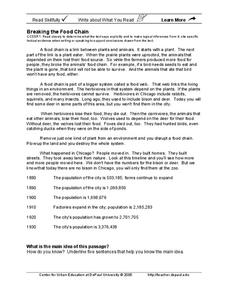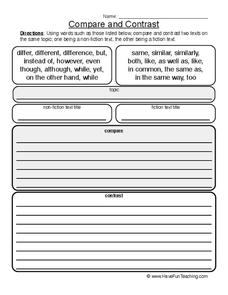Curated OER
Reading-Grade 3 Advanced 1
In this grade 3 reading worksheet, 3rd graders answer a set of 20 multiple choice "advanced" questions covering a variety of grade 3 concepts. Answers may be submitted online.
Curated OER
New York State Language Arts Test Grade 3
In this New York state language arts test worksheet, 3rd graders complete activities such as reading passages, answering comprehension questions, writing, and more. Students complete 28 problems.
Curated OER
Health Grade 3
Third graders understand what a friend is. In this lesson about friendships, 3rd graders analyze friend and non friend traits. Students learn about relationships through discussion in class. Students gather in groups and look at a list...
Curated OER
Abigail Adams: Integrating Social Studies and Language Arts
Third graders increase reading strategies while learning about Abigail Adams and her role in history. In this Abigail Adams lesson, 3rd graders read about the American Revolution and Abigail Adams using all the balanced literacy...
Curated OER
Third Grade Language
In this language assessment worksheet, students complete a 25 question multiple choice quiz. Included are: dictionary skills, sentence structure, reference materials and grammar.
Curated OER
Black History Lesson Plan: Gwendolyn Brooks
Learn more about the work of Gwendolyn Brooks with a language arts lesson. Young learners read an informational passage about the acclaimed poet before attempting a shape poem of their own.
Curated OER
Poetry: Simile And Figurative Language
Students explore websites that contain poems about autumn, winter, and the seasonal holidays and explore how similes and figurative language can be used in poetry.
EngageNY
On-Demand End of Unit Assessment and Bookmark Celebration
Using everything they have learned about writing paragraphs over the past few lessons of the unit, class members compose an informative paragraph independently. This is an authentic assessment of their ability, since learners have...
Reed Novel Studies
Stuart Little: Novel Study
Author E.B. White once had a dream about a small boy who acted like a rat, and that is how he conceived of his classic children's novel, Stuart Little. Using the novel study, scholars answer some questions based on their reading. Next,...
Bermingham City Schools
Opinion Writing
It's no secret that children can be very opinionated, but rather than fight against this natural tendency, embrace it with this primary grade writing project. After a shared reading of a children's book about persuasion, young learners...
K5 Learning
The Eagle and the Fox
How does a fox outsmart an eagle and all the creatures of the sea? Read about a tricky fox with a short story, followed by four comprehension questions about the plot and another possible endings.
K5 Learning
The Blind Men and the Elephant
Sometimes it's necessary to view the whole picture before making a judgment about a small part. Read a short story about five blind men who try to identify an elephant by feeling different parts and coming to their own conclusions....
Curated OER
Comparing and Contrasting Heroes
Here is a language arts lesson that can be used with virtually any grade level. The only thing that changes is the reading level of the books. Learners compare and contrast different heroes and the characteristics they hold. They use a...
Curated OER
The Fisherman and His Wife
Engage conversation and explore the journey as you challenge young readers to interpret the german folktale, "The Fisherman and His Wife" written by literary brothers Jacob and Wilhelm Grimm.
Curated OER
Tell a Ton of Tall Tales
Elementary schoolers read many tall tales. They create their own tall tale about a specific event of their choosing. They must act the part of the author. This well-designed lesson takes three class sessions to complete, and is...
Playbooks
Reader's Theater Exercise
Here's a great idea for your Parent/Family Night—host a Reader's Theater! Everything you need to organize the night, as well as a K-3 and a 4-7 script, is provided in the packet.
Scholastic
The Class Election from the Black Lagoon Storia Teaching Guide
One of my favorite things about this resource is that they use a standardized lexile to help you determine who should be reading what book. I also love this great teacher's guide for the book, The Class Election from the Black Lagoon. In...
Jupiter Images Corp.
To, Too, and Two
The most pesky of homophones: to, too and two! Here's a worksheet to help you review and discuss what homophones are and how to correctly use them in sentences. Learners choose the correct word for 20 sentences. This can serve as an...
NWT Literacy Council
Readers Theatre Scripts
Engage and entertain young learners with this collection of readers theatre activities. With over 25 different scripts, a wide range of topics are covered from simple counting and rhyming exercises to adaptions of popular children's...
Curated OER
Apple Adjectives
Study different apple varieties and use appropriate adjectives to describe them. Learners alphabetize both the apple names and the adjectives before creating spreadsheet, bar, and pie graphs. A mix of language arts, technology, and math!
Curated OER
Classifying Information About a Main Idea
Elementary learners explore language arts by completing a text identification activity. They discuss the importance of a main idea in a story or paper and how to present it properly. Then they practice identifying the main idea in sample...
DePaul University
Breaking the Food Chain
Throughout history, the growth of big cities has resulted in the destruction of ecosystems. In the case of Chicago, IL, a grassland that was once home to bison, deer, wolves, and foxes quickly became a booming city of over three million...
Have Fun Teaching
Compare and Contrast (3)
Sometimes the way a topic is presented in fiction can be very different from how it is in reality. Compare and contrast a topic from both a fiction and nonfiction source with a graphic organizer that prepares kids to write about what...
Hawaiʻi State Department of Education
Picture Poetry
What a fun idea! The class discusses, and then writes free-verse poems using sensory detail. They get into small collaborative writing teams to compose their poems. Next, they pantomime the actions from the poem while their teammates...





